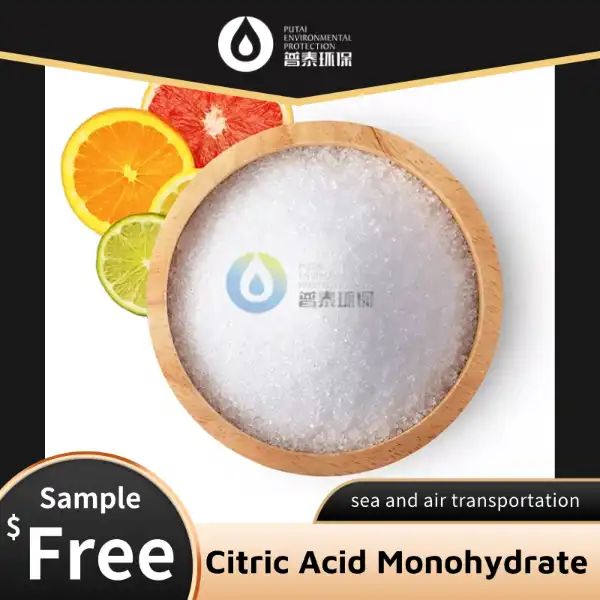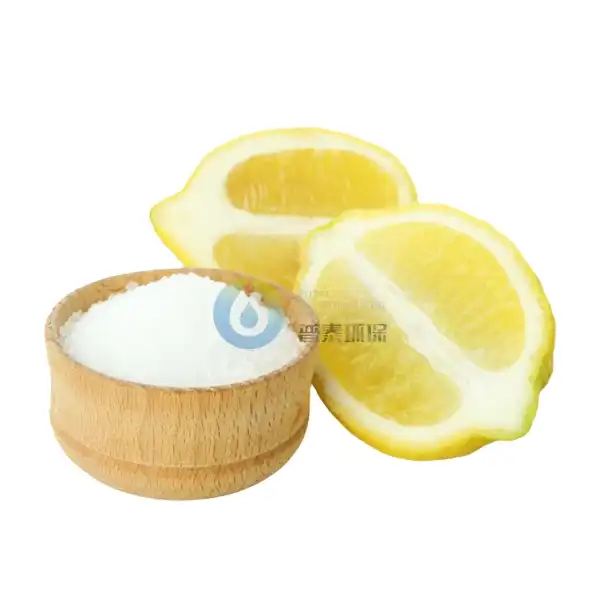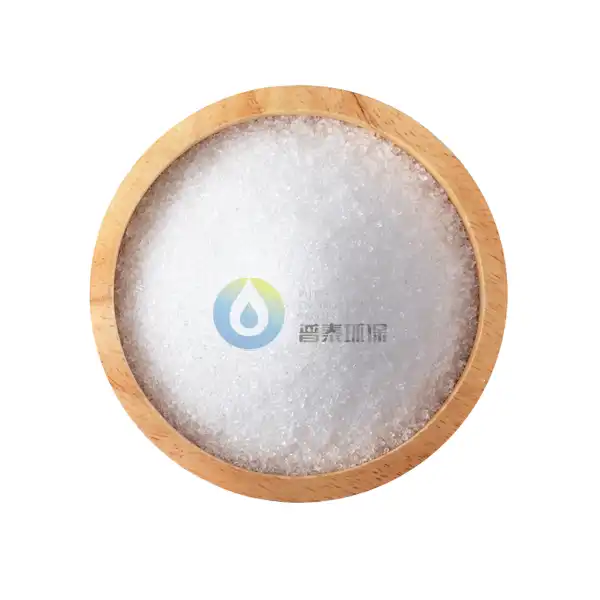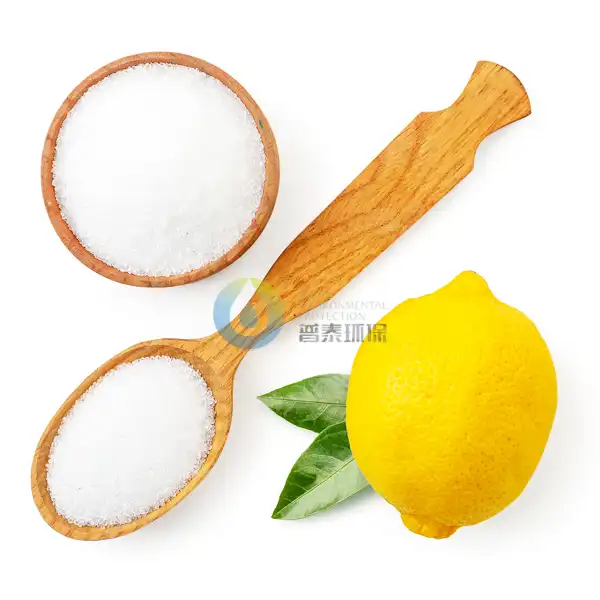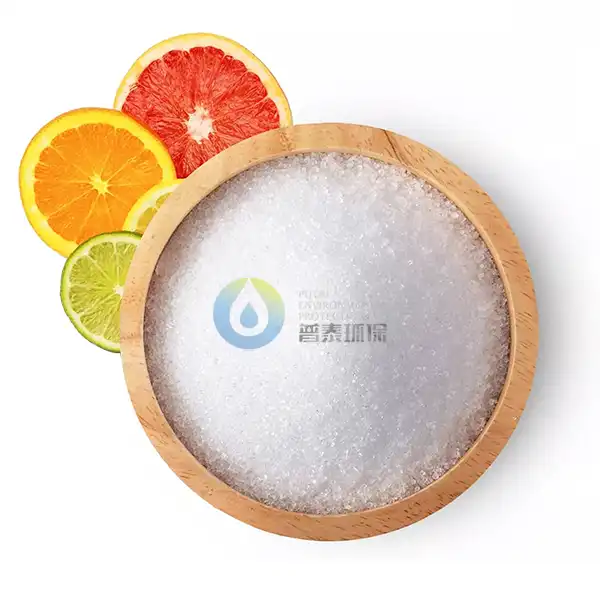What is the difference between Citric Acid Powder Anhydrous and Citric Acid Monohydrate?
Citric acid is a versatile compound widely used in various industries, from food and beverage to pharmaceuticals and cosmetics. When it comes to citric acid, there are two primary forms: Citric Acid Powder Anhydrous and Citric Acid Monohydrate. Understanding the differences between these two forms is crucial for selecting the right product for specific applications. This blog will explore the key distinctions between Citric Acid Powder Anhydrous and Citric Acid Monohydrate, their properties, and their uses in different industries.
What are the chemical differences between Citric Acid Powder Anhydrous and Citric Acid Monohydrate?
Molecular Structure
Citric Acid Powder Anhydrous and Citric Acid Monohydrate differ primarily in their molecular structure. Citric Acid Powder Anhydrous, as the name suggests, contains no water molecules in its crystal structure. Its chemical formula is C6H8O7, and it appears as a white, crystalline powder. On the other hand, Citric Acid Monohydrate has one water molecule attached to each citric acid molecule, resulting in the chemical formula C6H8O7·H2O. This additional water molecule affects the physical properties and behavior of the compound. The presence or absence of water in the molecular structure influences factors such as solubility, melting point, and stability, which are crucial considerations when choosing between the two forms for specific applications.
Water Content
The water content is a significant distinguishing factor between Citric Acid Powder Anhydrous and Citric Acid Monohydrate. Citric Acid Powder Anhydrous contains no water, making it a more concentrated form of citric acid. This characteristic is particularly advantageous in applications where moisture sensitivity is a concern or when a higher concentration of citric acid is required. In contrast, Citric Acid Monohydrate contains approximately 8.8% water by weight. This water content can affect the behavior of the compound in certain formulations and may require adjustments in recipes or manufacturing processes. The choice between anhydrous and monohydrate forms often depends on the specific requirements of the application, such as desired pH levels, solubility needs, or moisture sensitivity of other ingredients in a formulation.
Stability and Storage
The stability and storage requirements of Citric Acid Powder Anhydrous and Citric Acid Monohydrate differ due to their structural differences. Citric Acid Powder Anhydrous is generally more stable and less prone to caking or clumping during storage. Its anhydrous nature makes it less susceptible to moisture absorption from the environment, which can be advantageous in humid conditions or when long-term storage is necessary. However, it's important to note that Citric Acid Powder Anhydrous can be hygroscopic, meaning it can still absorb moisture from the air if not properly sealed. On the other hand, Citric Acid Monohydrate already contains water in its structure, making it less likely to absorb additional moisture from the environment. This can make it easier to handle in some manufacturing processes. Both forms require proper storage in airtight containers to maintain their quality and prevent moisture-related issues.
How do the applications of Citric Acid Powder Anhydrous differ from Citric Acid Monohydrate?
Food and Beverage Industry
In the food and beverage industry, both Citric Acid Powder Anhydrous and Citric Acid Monohydrate find extensive use, but their applications can differ based on specific requirements. Citric Acid Powder Anhydrous is often preferred in dry mixes, powdered beverages, and products where moisture control is crucial. Its anhydrous nature allows for better control of water content in the final product, which can be particularly important in applications such as confectionery, where moisture can affect texture and shelf life. Additionally, Citric Acid Powder Anhydrous is commonly used in effervescent tablets and powders due to its quick dissolution properties. On the other hand, Citric Acid Monohydrate is frequently used in liquid formulations, such as soft drinks, fruit juices, and sauces. Its pre-existing water content can make it easier to incorporate into aqueous solutions and may provide better stability in certain liquid products.
Pharmaceutical and Personal Care Products
In the pharmaceutical and personal care industries, the choice between Citric Acid Powder Anhydrous and Citric Acid Monohydrate often depends on the specific formulation requirements. Citric Acid Powder Anhydrous is commonly used in effervescent tablets, where its anhydrous nature contributes to the rapid dissolution and effervescent action when the tablet is added to water. It's also preferred in moisture-sensitive formulations, such as certain types of tablets or powders, where controlling water content is crucial for product stability and efficacy. In contrast, Citric Acid Monohydrate is often used in liquid pharmaceutical preparations, such as oral solutions or suspensions, where its pre-existing water content can be advantageous. In personal care products, Citric Acid Powder Anhydrous may be used in anhydrous formulations like certain types of bath bombs or powder-based products, while Citric Acid Monohydrate might be preferred in aqueous-based skincare or haircare formulations.
Industrial and Technical Applications
In industrial and technical applications, the choice between Citric Acid Powder Anhydrous and Citric Acid Monohydrate can significantly impact process efficiency and product quality. Citric Acid Powder Anhydrous is often preferred in applications where precise control of acidity is required, such as in pH adjustment of industrial processes or in the production of certain chemicals. Its anhydrous nature allows for more accurate dosing and can be advantageous in reactions where water content needs to be minimized. Additionally, Citric Acid Powder Anhydrous is commonly used in the manufacturing of biodegradable plastics, where its ability to control moisture is crucial for the polymerization process. On the other hand, Citric Acid Monohydrate may be preferred in applications where easier dissolution in aqueous solutions is desired, such as in certain cleaning products or water treatment processes. The choice between the two forms in industrial applications often comes down to factors such as process requirements, desired pH levels, and the presence of other moisture-sensitive components in the system.
What are the key considerations when choosing between Citric Acid Powder Anhydrous and Citric Acid Monohydrate?
Solubility and Dissolution Rate
When choosing between Citric Acid Powder Anhydrous and Citric Acid Monohydrate, solubility and dissolution rate are crucial factors to consider. Citric Acid Powder Anhydrous generally exhibits a higher solubility in water compared to Citric Acid Monohydrate. This increased solubility can be advantageous in applications where rapid dissolution is required, such as in effervescent tablets or instant beverage mixes. The anhydrous form tends to dissolve more quickly, which can lead to faster pH adjustment in solutions. However, it's important to note that the rapid dissolution of Citric Acid Powder Anhydrous can sometimes result in localized areas of high acidity, which may be a consideration in sensitive formulations. On the other hand, Citric Acid Monohydrate, while slightly less soluble, often provides a more controlled dissolution rate. This can be beneficial in applications where a gradual release of acidity is desired or where a more uniform distribution of the acid in a solution is needed.
pH Control and Buffering Capacity
Both Citric Acid Powder Anhydrous and Citric Acid Monohydrate are effective pH regulators and buffers, but their performance can differ slightly in various applications. Citric Acid Powder Anhydrous, due to its higher concentration of citric acid per unit weight, can provide more acidic strength and buffering capacity compared to an equal weight of Citric Acid Monohydrate. This makes it particularly useful in applications where strong pH control is required or where space and weight considerations are important. For instance, in the production of effervescent tablets or powders, Citric Acid Powder Anhydrous can offer more efficient pH adjustment and CO2 generation. However, in some liquid formulations, the more gradual pH change provided by Citric Acid Monohydrate might be preferable. The choice between the two forms for pH control often depends on the specific pH range required, the other ingredients in the formulation, and the desired rate of pH change.
Cost and Efficiency Considerations
When deciding between Citric Acid Powder Anhydrous and Citric Acid Monohydrate, cost and efficiency are important factors to consider. Citric Acid Powder Anhydrous is generally more expensive per unit weight compared to Citric Acid Monohydrate. This price difference is primarily due to the additional processing required to remove all water from the citric acid molecule. However, the higher cost of Citric Acid Powder Anhydrous can be offset by its increased potency. Since it contains no water, a smaller amount of the anhydrous form is needed to achieve the same acidity level as a larger amount of the monohydrate form. This can lead to savings in shipping, storage, and handling costs, especially for large-scale industrial applications. Additionally, the anhydrous form's resistance to caking can improve efficiency in manufacturing processes by reducing the need for anti-caking agents or special handling procedures. On the other hand, Citric Acid Monohydrate, while less concentrated, may be more cost-effective for applications where its properties are sufficient and where the presence of water in the formulation is not a concern.
Conclusion
In conclusion, the choice between Citric Acid Powder Anhydrous and Citric Acid Monohydrate depends on various factors including the specific application, formulation requirements, desired properties, and cost considerations. Citric Acid Powder Anhydrous offers advantages in terms of concentration, moisture control, and rapid dissolution, making it suitable for dry mixes, effervescent products, and moisture-sensitive applications. Citric Acid Monohydrate, with its built-in water content, is often preferred in liquid formulations and where gradual dissolution is desired. Understanding these differences is crucial for manufacturers and formulators to select the most appropriate form of citric acid for their specific needs, ensuring optimal product performance and efficiency in various industries.
Xi'an Putai Environmental Protection Co., Ltd. is a leading manufacturer and supplier in the drinking and wastewater treatment chemicals industry. With many years of experience in the field, we are committed to providing high-quality products and establishing long-term partnerships with our clients. Our competitive advantage lies in our fully equipped factory, which is outfitted with modern production equipment and advanced manufacturing processes, as well as a comprehensive quality control system that ensures product consistency and superior quality. Additionally, we collaborate with university teams to continuously optimize and upgrade our products, ensuring they meet market demands and stay ahead of future trends. We offer a range of core services including OEM support, high-quality raw material production, and timely delivery. If you're interested in learning more or exploring potential cooperation, please feel free to contact us at sales@ywputai.com. We look forward to the opportunity to work with you.
References
1. Smith, J.A. (2019). "Citric Acid in Food and Beverage Applications: A Comprehensive Guide." Journal of Food Science and Technology, 56(4), 1523-1540.
2. Johnson, M.B., & Williams, R.T. (2020). "Comparative Analysis of Citric Acid Anhydrous and Monohydrate in Pharmaceutical Formulations." International Journal of Pharmaceutical Sciences and Research, 11(8), 3789-3801.
3. Brown, L.K., et al. (2018). "Industrial Applications of Citric Acid: Anhydrous vs. Monohydrate Forms." Chemical Engineering Progress, 114(9), 45-53.
4. Garcia, E.F., & Rodriguez, H.P. (2021). "Stability and Storage Considerations for Citric Acid Powder Anhydrous and Monohydrate." Journal of Chemical Engineering & Process Technology, 12(3), 467-475.
5. Thompson, D.R. (2017). "Citric Acid in Personal Care Products: Formulation Strategies and Performance Differences." International Journal of Cosmetic Science, 39(6), 592-601.
6. Lee, S.Y., & Park, J.H. (2022). "Recent Advances in Citric Acid Production and Applications: A Review." Biotechnology Advances, 54, 107809.

